
H.L. Mencken, the sharp-witted satirist and critic of early 20th-century American life, once wrote, “For every complex problem, there is an answer that is clear, simple, and wrong.”1 Mencken, born in Baltimore in 1880, was known for his incisive critiques of societal norms and his skepticism of simplistic solutions to complex issues.
Mencken’s wisdom applies to both everyday life and technical fields. His insights are particularly relevant in the engineering, manufacturing, and reliability disciplines, where the temptation to seek easy answers can lead to costly errors. We’ll start with a relatable everyday example before exploring documented cases in engineering and manufacturing that demonstrate the pitfalls of oversimplified solutions.
[Read more…]









